When considering our dogs, their playful antics and loyal companionship often come to mind. Yet, one of the most intriguing aspects of these furry friends is their unique perception of the world. Dogs experience their surroundings differently than humans, and this understanding can enhance our appreciation for them and help us meet their needs more effectively.
Unique Visual System
Dogs possess a distinct visual system with different types of photoreceptors compared to humans. While humans have three types of cones for a broad spectrum of colors, dogs have only two. This limits their color perception primarily to shades of blue and yellow, making it challenging for them to distinguish between red and green. A bright red ball may appear as a dull brown to a dog, whereas a blue toy would stand out more vividly.
Adaptations for Night Vision
The structure of a dog’s eye contributes to its ability to see in low-light conditions. With larger corneas and lenses, dogs can take in more light, a trait inherited from their ancestors. Their night vision is significantly superior to ours, enabling them to navigate their environment even in darkness. This remarkable ability is due to the tapetum lucidum, a layer of cells behind the retina that reflects light, providing photoreceptors with an additional opportunity to capture it.
Field of Vision
Dogs enjoy a wider field of vision compared to humans. While we can see about 180 degrees, dogs can see up to 240 degrees. This broader view aids in detecting movement, which is crucial for survival. However, this advantage comes with a trade-off: dogs do not see as sharply as humans. Their visual acuity is estimated at about 20/75, meaning they may struggle to recognize objects or people until they are closer.
Sensitivity to Motion
Dogs are particularly attuned to movement, an evolutionary trait that enhances their hunting and predator-avoidance skills. They can detect even slight motions, making them adept at spotting fast-moving objects, like a squirrel darting across the yard. This sensitivity, combined with their expanded field of vision, equips them to track changes in their surroundings effectively.
The Power of Smell
While dogs may not perceive the world in vibrant colors, they excel in other sensory areas, particularly olfaction. Their sense of smell far surpasses that of humans. This means that, although their visual world may be limited, their olfactory environment is rich and detailed. Dogs can detect scents from great distances and identify different smells with remarkable accuracy. This olfactory prowess complements their vision, enabling them to create a fuller understanding of their surroundings.
Choosing the Right Toys
Understanding how dogs see helps in selecting appropriate toys. Toys in blue and yellow are more likely to capture a dog’s attention than those in red or green. Additionally, being mindful of their visual limitations can create a safer environment. Clear and well-lit pathways aid their navigation, especially during the night.
Multisensory Interpretation
Dogs do not rely solely on their vision; they employ a multisensory approach to interpret their environment. Their acute sense of hearing allows them to detect sounds at higher frequencies than humans can perceive, alerting them to things we might miss. This ability enriches their understanding of the world around them.
Strengthening the Bond
The emotional connection between dogs and humans transcends their differing perceptions of the world. While our views may vary, the bond we share is built on shared experiences. Dogs depend on us for companionship and support, while we cherish their unwavering loyalty. Understanding their perceptual world can enhance this relationship, fostering better communication and meeting their needs more effectively.
Responsible Pet Ownership
Recognizing the limitations of a dog’s vision can lead to more responsible pet ownership. If a dog appears hesitant in new environments, it may be linked to their visual challenges. Creating a sense of security in unfamiliar settings can significantly enhance their comfort. Gentle encouragement and positive reinforcement can assist dogs in navigating new experiences with confidence.
Monitoring Eye Health
Certain health issues, such as cataracts or progressive retinal atrophy, can impair a dog’s vision. Being vigilant for signs of vision problems is crucial for early detection and intervention. Regular veterinary check-ups play an essential role in monitoring eye health and addressing potential concerns before they escalate.
Embracing Different Perspectives
Dogs perceive the world through a unique lens, with advantages and limitations that shape their experiences. Their ability to perceive motion, wide field of vision, and enhanced night vision contribute to their comprehension of their surroundings. Although their color perception is limited, their extraordinary sense of smell allows for a rich exploration of the world.
Appreciating how dogs see their environment deepens our connection with them. By acknowledging their needs and perspectives, we cultivate a relationship founded on trust, companionship, and mutual understanding. Dogs remind us of the beauty in diverse viewpoints and the importance of embracing different ways of experiencing the world, enriching our lives together in the process.


